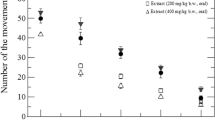Abstract
The effect of antidepressant treatments have traditionally been discussed primarily in terms of effects on noradrenergic and serotonergic systems. Mucuna Pruriens L (D.C) (Leguminoseae) is widely used in Indian folk medicine in variety of disease conditions. Based on nervous protective action of Mucuna Pruriens seeds, investigation of noradrenaline and serotonin mediated antidepressant action of hydroalcoholic extract of the M. Pruriens seeds (MPE) (200 mg/kg, p.o) was carried out using forced swimming test (FST) and tail suspension test (TST) in mice. Further, combination of MPE with Reboxetine (1 mg/kg, i.p.), Prazosin (62.5 μg/kg, i.p.), Fluoxetine (20 mg/kg, i.p.) and p-chlorophenyl alanine (p-CPA 100 mg/kg, i.p.) were also studied in both the tests. Noradrenaline and serotonin neurotransmitters were measured in whole brain of mice after 14 days treatment of MPE. Result of the present study indicated that 7 days and 14 days treatment of MPE produced significant reduction of the immobility time in the FST and TST respectively. Further, antidepressant like activity of MPE was significantly reduced by Prazosin and enhanced by Reboxetine in the FST and TST. Antidepressant like action of MPE was also significantly reduced by p-CPA and enhanced by Fluoxetine in the both FST and TST. The neurotransmitter estimations revealed the levels of noradrenaline and serotonin were increased with 14 days MPE treatment. Reboxetine potentiated and Prazosin reversed MPE mediated rise of noradrenaline level. Similarly, Fluoxetine potentiated and p-CPA reversed MPE mediated rise of serotonin level. From the results of the present study, it is concluded that hydroalcoholic extract of M. Pruriens seeds possess antidepressant like property which may be mediated via interaction with the noradrenergic and serotonergic systems.
Similar content being viewed by others
References
Galani VJ, Patel BG (2010) Effect of hydroalcoholic extract of Sphaeranthus indicus against experimentally induced anxiety, depression and convulsions in rodents. Int J Ayu Res 1:87–92
Gold PW, Goodwin FK, Chrousus GP (1988) Clinical and biochemical manifestations of depression: relation to the neurobiology of stress: part 1. N Engl J Med 319:348–353
Jacobowitz DM, Richardson JS (1978) Method for the rapid determination of norepinephrine, dopamine, and serotonin in the same brain region. Pharmacol Biochem Behav 8:515–519
Kokate CK (1994) Practical Pharmacognosy, 4th edn. Vallabh prakashan, New Delhi, India, pp 107–109
Manyam BV, Dhanasekaran M, Hare TA (2004) Neuroprotective effects of the antiparkinson drug Mucuna pruriens. Phytother Res 18:706–712
Páez PM (2005) New drug targets in the signalling pathways activated by antidepressants. Prog Neuropsychopharmacol Biol Psychiatry 29:1010–1016
Patel JS, Galani VJ (2011) Investigation of serotonergic and noradrenergic system mediated antidepressant action of Mucuna pruriens seeds using chronic unpredictable mild stress test in mice. Inventi Impact: Ethnopharmacology, 3, Article ID-Inventi:pep/499/11. http://www.inventi.in/Article/pep/499/11.aspx
Pati D, Pandey DK, Mahesh R, Kurdekar V, Jhadav HR (2010) Antidepressant like activity of Mucuna Pruriens; a traditional Indian herb in rodent models of depression. Pharmacologyonline 1:537–551
Pineyro G, Blier P (1999) Autoregulation of serotonin neurons: role in antidepressant drug action. Pharmacol Rev 51:533–591
Porsolt R, Berlin A, Jalfre M (1977) Behavioural despair models in mice: a primary screening test for antidepressants. Arch Int Pharmacodyn Ther 229:327–336
Rastogi RP, Mehrotra BN (1994) Compendium of Indian medicinal plants, vol 5. CDRI, Lucknow, p 554
Sathiyanarayanan L, Arulmozhi S (2007) Mucuna pruriens Linn. - A comprehensive review. Pharmacogn Rev 1:157–162
Steru L, Chermat R, Thierry B, Simone P (1985) The tail suspension test: a new method for screening antidepressants in mice. Psychopharmacology (Berl) 37:367–370
Thierry B, Stéru L, Simon P, Porsolt RD (1986) The tail suspension test: ethical considerations. Psychopharmacology (Berl) 90:284–285
Victor IR (2005) Mental disorders. In: Kasper B (ed) Harrison’s Principle of internal medicine, 16th edn. McGraw-Hill, New York, pp 2551–2552
Warrier PK, Nambiar NP, Ramakutty C (1995) Indian medicinal plants-a compendium of 500 species, Vol 4. Orient Longman Ltd, Madras, pp 68–72
WHO (1999) WHO Director-General unveils new global strategies for mental health, Press Release, WHO/99-67. Available from: http://www.who.int/inf-pr-1999/en/pr99-67. html
Willner P (1984) The validity of animal model of depression. Psychopharmacology (Berl) 83:1–16
Author information
Authors and Affiliations
Corresponding author
Rights and permissions
About this article
Cite this article
Patel, J.S., Galani, V.J. Investigation of noradrenaline and serotonin mediated antidepressant action of Mucuna pruriens (L) D.C seeds using various experimental models. Orient Pharm Exp Med 13, 143–148 (2013). https://doi.org/10.1007/s13596-012-0089-8
Received:
Accepted:
Published:
Issue Date:
DOI: https://doi.org/10.1007/s13596-012-0089-8




